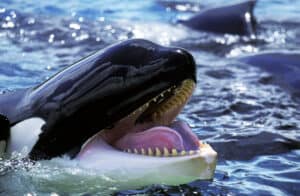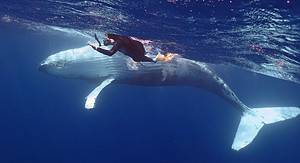Also known as the white whale due to its ghostly white body coloration, the adorable and quirky beluga whale is an incredibly unique animal. But just how big is an average beluga whale, and what is its maximum size? How big are baby belugas when they are born? Finally, how do they measure up to other cetaceans, marine animals, and even humans? Read on to learn everything you need to know about the beluga whale’s size, as well as some interesting facts about the species!
An Introduction to the Beluga Whale: Fun Facts and Overview

Beluga whales are very social and often gather in groups of anywhere from 10 to several hundred individuals.
©Luna Vandoorne/Shutterstock.com
Taxonomically, the beluga whale is one of two living members of the Monodontidae family, along with the closely related narwhal. Like the narwhal, it is fairly small compared to most other cetaceans like whales, dolphins, and porpoises. Both species lack dorsal fins, though they do have a thin, raised ridge along their backs similar to a dorsal fin.
Like most other whales, the beluga is highly intelligent, social, and vocal–it often uses echolocation to communicate and navigate the chilly Arctic and sub-Arctic waters in which it lives. It’s perfectly suited for these ice-cold conditions, in part thanks to its uniform white body color that helps camouflage it somewhat.
Additionally, the beluga lacks a dorsal fin, which allows it to swim underneath ice sheets unhindered. It also uses a large, protruding spongy organ with a hardened crest in its head, called a melon, to better navigate via echolocation and find holes in the ice so it can occasionally come up for oxygen. If necessary, it can even bash through thin sheets of ice using its melon to create breathing holes for itself.
More broadly speaking, beluga whales are toothed whales, making them part of the Odontoceti taxonomic parvorder. The beluga whale is one of around 73 total species of toothed whales. They mainly differ from baleen whales by having true teeth in their mouths instead of keratin-based baleen plates ideal for filter feeding.
How Big Are Beluga Whales When They Are Born?
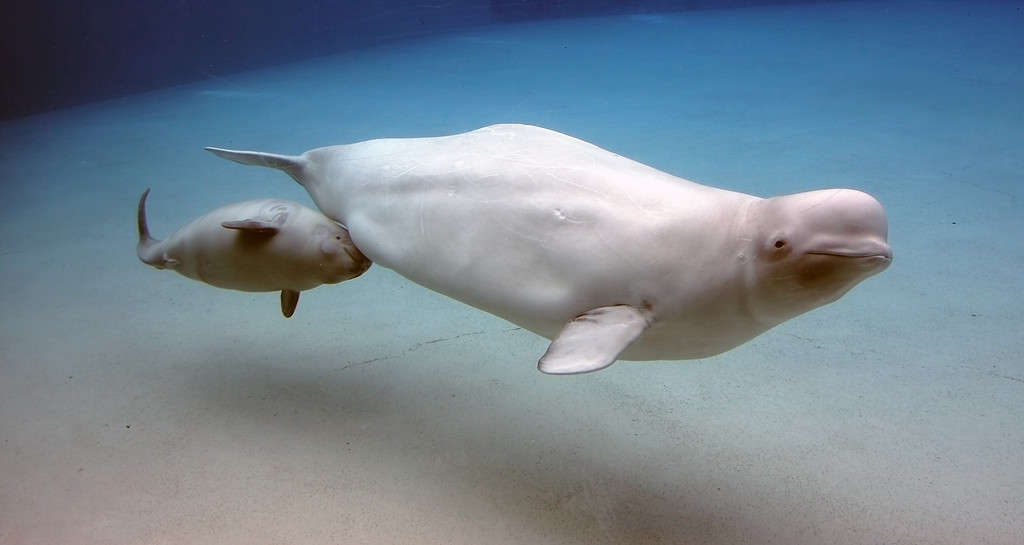
Baby and juvenile beluga whales stay close to their mothers for the first few years of their lives.
©Christopher Meder/iStock via Getty Images
At birth, a baby beluga whale is around 5 feet long and weighs around 150 pounds. Their mothers give birth to one calf at a time, typically once every three years or so. Although adult belugas are a uniform, stark white color, babies start their lives a dark grayish-brown to grayish-blue color.
Over the next few months, this grayish color darkens slightly before eventually lightening with age. Their bodies do not turn white until they are around 10 to 12 years old, meaning a beluga’s body color can be an accurate indicator of their approximate age. Interestingly, their teeth can also help indicate a beluga’s age, as they gain small distinctive growth marks every year.
Newborn beluga whales generally emerge from their mothers’ bodies tail-first, and their mothers immediately help guide them to the water’s surface for their first breath. Because baby belugas lack a thick layer of protective blubber to keep them warm, beluga whale mothers tend to give birth in warmer waters before eventually traveling north with their young much later.
Baby beluga whales stay very close to their mothers’ sides for the first few years of their lives, not reaching maturity until they are around 4 to 7 years old.
How Big Are Beluga Whales?
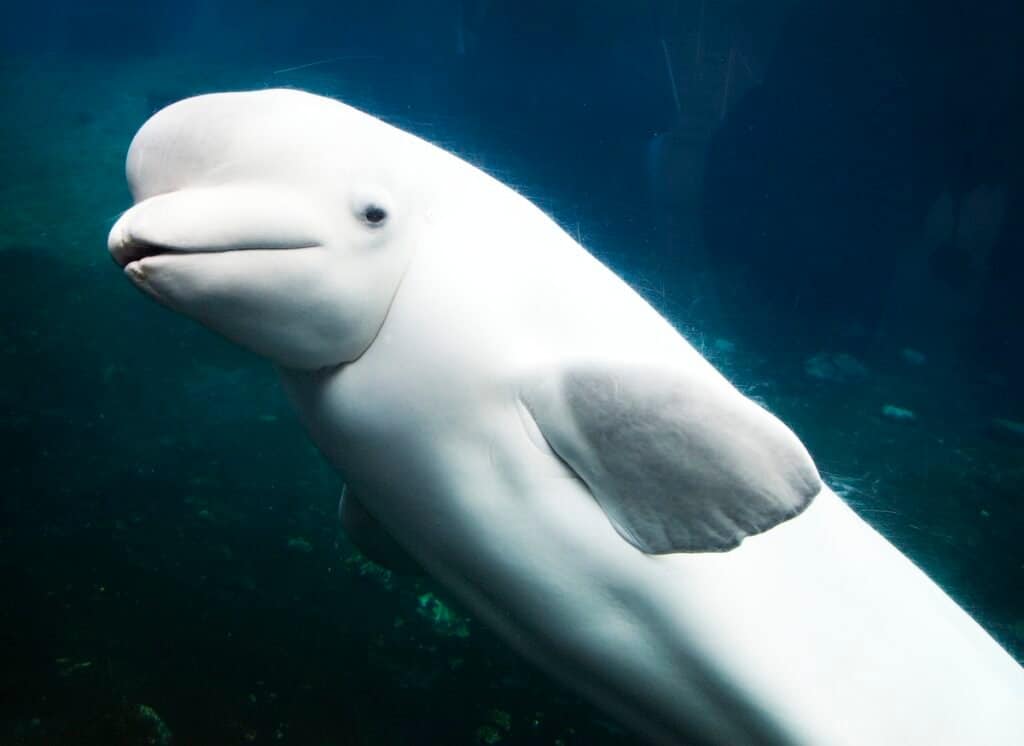
Beluga whales have thick, stocky bodies full of blubber to keep them warm in Arctic and sub-Arctic waters.
©Carol M Highsmith / CC0 1.0, Rawpixel – License
Beluga whales mature fairly slowly, reaching sexual maturity at around 4 to 7 years old but not achieving their full size until as late as 10 years of age. As a sexually dimorphic species, females are smaller and shorter in total body length than males.
When fully grown, a typical male beluga whale weighs between 2,000 and 3,000 pounds and measures between 11 and 16 feet long. By comparison, mature females weigh around 1,500 to 2,000 pounds and can reach between 10 to 13 feet in length, though they rarely exceed 12 feet.
Much of a beluga whale’s body is made up of blubber, a thick layer of fat that helps keep them warm and their organs protected while swimming in cold, Arctic, and sub-Arctic waters. A mature beluga whale can have a blubber layer up to around 5 inches thick!
What is the Largest Beluga Whale Ever Recorded?
Currently, no comprehensive data exists on the largest beluga whale individual ever recorded. However, especially large male belugas can reach close to 18 feet long and weigh more than 3,500 pounds. As we touched on earlier, males tend to be longer and heavier than females, but very large females can still occasionally grow to be around 13 feet long and weigh close to 3,000 pounds.
Additionally, some beluga whales in captivity have reached impressively large sizes. For example, Shedd Aquarium in Chicago, Illinois, is home to eight beluga whales. Their largest, named Aurek, is a male weighing 2,100 pounds and measuring 14 feet long. He was born in 2003 and has lived at the aquarium since 2017. Aurek isn’t just the largest beluga on-site–he’s the largest animal at Shedd Aquarium!
Beluga Whale Vs. Human Size Comparison
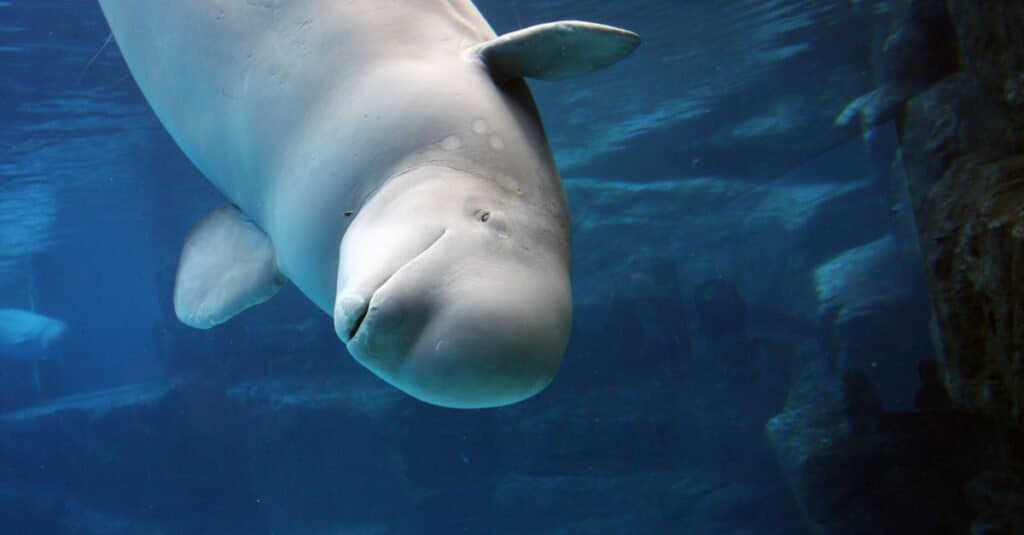
Newborn beluga whales are approximately the same size as a small adult human, while mature belugas can be more than twice as long and close to 20 times heavier than the average human adult.
©Christopher Meder/Shutterstock.com
Even at birth, a beluga whale is about the size of an adult human! As we covered above, newborn beluga whales are around 5 feet long and weigh around 150 pounds. Furthermore, a fully mature beluga whale can be more than twice as long as an average human’s height–male belugas are around 11 to 16 feet long, while females are around 10 to 12 feet in total body length.
Beluga whales also significantly outweigh humans at 1,500 to over 3,500 pounds on average depending on their sex and age. Considering an average human adult can weigh anywhere from 120 to 250 pounds, this means a beluga whale can be anywhere from 5 to 20 times our size in weight!
Are Beluga Whales Bigger Than Orcas?
Compared to the killer whale, also known as the orca, beluga whales are much smaller both by length and weight. A newborn orca typically weighs between 250 and 350 pounds and measures around 8 feet long. That makes newborn belugas around half the size of baby orcas. As they grow, this size disparity continues to widen–after all, orcas are the largest members of the dolphin family!
When fully mature, an average killer whale weighs between 8,000 and 13,000 pounds and measures 20 to 25 feet long. Similar to beluga whales, orcas are sexually dimorphic, with males being much larger and longer than females. All things considered, this makes the average orca around 3 to 5 times as large and long as a beluga whale.
Are Beluga Whales Bigger Than Dolphins?
In general, beluga whales are around the same size or slightly larger than most of the 40 or so known dolphin species. The smallest living dolphin species, the Hector’s dolphin, typically measures between 4 and 5 feet long and weighs around 120 pounds. This makes beluga whales around two to three times as long and 10 to 30 times as heavy as Hector’s dolphins.
Compared to better-known species like the bottlenose dolphin, belugas are heavier yet around the same size in total body length. The average mature bottlenose dolphin weighs around 650 pounds and is about 13 feet long. However, as we touched on above, the largest known dolphin species (the orca) is significantly larger and longer than a typical beluga whale, or around 3 to 5 times as large and long.
The photo featured at the top of this post is © Christopher Meder/iStock via Getty Images
Thank you for reading! Have some feedback for us? Contact the AZ Animals editorial team.





